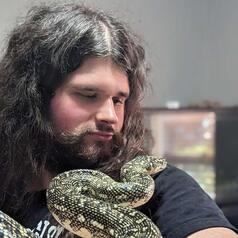 On this Student Spotlight: The extinction of the dinosaurs is still being studied.
On this Student Spotlight: The extinction of the dinosaurs is still being studied.
Kyle Atkins, PhD student in ecology at Oklahoma State University, explores a new finding that can change our understanding of the event.
I am a PhD student interested in the ecology of terrestrial environments at the very end of the age of dinosaurs. When I’m not working on fossils or simulations via 3D modeling, I am working with live reptiles. I believe that hands-on experience with living animals is vital to understanding the lives of extinct creatures, so I try to keep one foot in each world.
What a New “Hell Chicken” Can Tell Us About Dinosaur Extinction
For decades, there has been fierce debate about how the dinosaurs died. Was the asteroid merely the finishing blow on an already-dying group, or were dinosaurs flourishing to the very end? Our new discovery helps shed light on this issue.
During the late 1970s, paleontologists noted a decline in the number of dinosaur species over the final 10 million years of the Cretaceous Period. Some suggested that this was evidence for gradual extinction of the dinosaurs. Others disagreed, citing the many confounding factors that could cause such a pattern.
Fast forward to just a few years ago. I obtained a partial hindlimb that I presumed to be a juvenile dinosaur from the very end of the Cretaceous, Anzu wyliei. affectionately called the “chicken from hell” on account of its large size (standing nearly 5 feet tall at the hip and weighing as much as a grizzly bear). Much to our surprise, when we looked at the bones to estimate its age and growth rate, we found that it was a subadult specimen of a completely new, second species of “hell chicken.” We named this new dinosaur Eoneophron infernalis, translating to “Pharaoh’s chicken from hell.”
This prompted us to re-evaluate the diversity of “hell chickens,” formally called caenagnathids, at the end of the cretaceous. Before our study, there was only a single species from this time, Anzu – an apparent decrease compared to the three species found just 8-10 million years prior. Now, we have two named species, and we found evidence for a third.
This tells us that caenagnathids did not decrease in diversity in the final stages of the Cretaceous. This shows that at the very least, some groups of dinosaurs were doing quite well before the asteroid hit.
